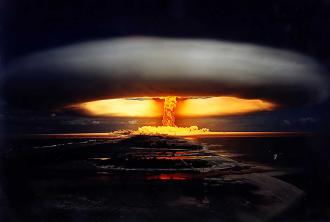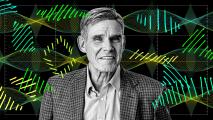Let’s begin with a brief account of how nuclear weapons were developed. Frederick Soddy and Ernest Rutherford discovered that radioactive decay involves the transmutation of one type of atom into another, which led to worries about a “planetary chain reaction” of infectious decay that converts the chemical mosaic of Earth’s elements into helium. In the process, a huge amount of energy would be liberated, according to the equation E = mc2, which led some to speculate about the causes of nova observed in the firmament. Later, in 1934, Irene and Frédéric Joliot-Curie figured out how to convert certain stable atoms into radioactive atoms, by which time the notion of “atomic energy” had inspired a profusion of utopian and dystopian proclamations about its potential to usher in a post-scarcity world or tear the planet asunder.
A notable example that combined both themes was H.G. Wells’ 1914 novel The World Set Free, which was written the previous year and dedicated to Soddy’s work on radium. This book describes a catastrophic world war (initiated by Germany in the 1950s, as it happens) that ultimately leads to the creation of a harmonious world state. What is most relevant for our purposes is that the war involves what Wells called, coining the term, “atomic bombs” that pilots fling from their cockpits on urban centers below, destroying entire cities. However, these are not like the “atomic bombs” dropped on Hiroshima and Nagasaki in 1945; rather than producing a sudden massive explosion, they utilize a fictional radioactive element called “Carolinum” to generate “a blazing continual explosion” that “is never entirely exhausted,” and which would create “puffs of luminous, radio-active vapour drifting sometimes scores of miles from the bomb centre and killing and scorching all they overtook.”
Although this was science fiction, the idea greatly influenced one of the pioneers of nuclear weapons: a young Hungarian physicist named Leó Szilárd, who read The World Set Free in 1932 and included Wells within his circle of acquaintances. As the now-famous story goes, Szilárd read an article in The Times the following year that quoted Rutherford as saying that “anyone who looked for a source of power in the transformation of the atoms was talking moonshine.” The reason is that, as another newspaper article on Rutherford’s talk explained, “walls of electric energy surround the nucleus. To break down wall after wall and eventually reach the holy of holies [i.e., the nucleus] in which almost incredible energy is concentrated, the physicist must lay siege to the atom. So he tries to batter it and blast it apart” by shooting alpha particles at the nuclei. The problem is that only “one particle in 10,000,000 strikes the nucleus,” meaning that the process is extremely inefficient (quoting here a New York Times article published the same day on Rutherford’s comments).
Finding himself “irritated” by Rutherford’s confidence Szilárd went for a walk and, standing at a street corner in London, devised a method for unlocking the vast stores of energy trapped in atomic nuclei: a nuclear chain reaction. Whereas earlier experiments had involved alpha particles, which consist of two protons and neutrons (the latter of which were first discovered in 1932), Szilárd instead imagined bombarding atoms with free neutrons, which unlike alpha particles have a neutral rather than positive charge. This would enable them to easily trespass the aforementioned “walls of electric energy,” thus striking a greater number of nuclei. Furthermore, Szilárd reasoned that if an atom struck by a free neutron were to subsequently release two additional neutrons, the process — the chain reaction — could become exponential and self-sustaining. Over just a few millionths of a second, billions of atoms could be struck by and release neutrons, thereby liberating enormous quantities of energy at once rather than (as with natural radioactive decay) over protracted stretches of time. Szilárd quickly realized that, as he later wrote, “in certain circumstances it might become possible to set up a nuclear chain reaction, liberate energy on an industrial scale, and construct atomic bombs.”
This was the abstract idea, but could it work? Are there elements whose atoms release two neutrons when struck by one? If so, which elements? An important step toward answering these questions came in 1938 with the discovery of nuclear fission in uranium atoms by a team of scientists in Berlin, the capital of Nazi Germany, which found that irradiating uranium with neutrons causes the atoms to split into fragments. Upon hearing about this the following year, Szilárd, in his words, “saw immediately that these fragments… must emit neutrons, and if enough neutrons are emitted in this fission process, then it should be, of course, possible to sustain a chain reaction. All the things which H.G. Wells predicted,” he continued, “appeared suddenly real to me.” Now the crucial question became, “Is this actually the case? Does uranium fission produce neutrons and, if so, how many?”
Flashes appearing on the oscillograph’s display screen would indicate that uranium does indeed produce neutrons.
To answer the first question — to confirm his suspicions — Szilárd conducted an experiment with his colleague Walter Zinn in March of 1939. It involved using a cathode-ray oscillograph to track the movements and kinetic energy of neutrons that might be released by uranium atoms when split by slow neutrons striking them. Flashes appearing on the oscillograph’s display screen would indicate that uranium does indeed produce neutrons, which “in turn would mean that the large-scale liberation of atomic energy was just around the corner.” After initiating the experiment, Szilárd and Zinn were relieved that no flashes appeared, although they soon realized that the screen had been unplugged. Once the screen was powered on, the two scientists “turned the switch and saw the flashes,” Szilárd later recalled. “We watched them for a little while and then we switched everything off and went home,” he says. “That night, there was very little doubt in my mind that the world was headed for grief.”
Having spent much of the 1930s anxious that atomic energy — more accurately called nuclear energy — could be weaponized to produce “atomic bombs,” Szilárd scheduled a meeting with Einstein in a Peconic, Long Island cottage where Einstein was staying. Szilárd explained how nuclear energy could be unlocked and turned into a bomb, to which Einstein reportedly said, “I haven’t thought of that at all.” Worried that the world was on the brink of another war and that Nazi Germany might develop an atomic bomb, Szilárd penned a letter — now called the “Einstein-Szilárd letter” — intended for U.S. President Franklin Roosevelt to alert him of the danger. He noted that “some of the American work on uranium is now being repeated” at a Berlin-based university with connections to the German Under-Secretary of State, and that Nazi “Germany has actually stopped the sale of uranium from… the German Under-Secretary of State,” and that “Germany has actually stopped the sale of uranium from the Czechoslovakian mines which she has taken over.”
This letter, whose only signatory was Einstein, spurred the creation of the Manhattan Project, described by some as the first “Big Science” project in history, which aimed to design, build, and test the first atomic bombs. It cost $2 billion USD ($23 billion in 2018 dollars) and involved more than 130,000 scientists, although only a handful were aware of the project’s details and ultimate goals. The research arm of the endeavor, based in the top-secret Los Alamos Laboratory near Santa Fe, New Mexico, was run by the physicist, child prodigy, and chainsmoker (an incredible four to five packs per day) Robert Oppenheimer, known today as the “Father of the Atomic Bomb.”
The first atomic bomb, nicknamed the “Gadget,” was detonated at 5:29 in the morning on July 16, 1945, in the desert of Jornada del Muerto, sometimes translated as “Journey of the Dead Man,” in New Mexico. This was the Trinity test, which created a burst of smoke and fire that rapidly rose 40,000 feet into the early morning sky. Less than a month later, on the 6th and 9th of August, the United States dropped two atomic bombs — Little Boy, a uranium bomb, and Fat Man, a plutonium bomb — on the Japanese archipelago, killing more than 100,000 people and helping, some argue, to bring World War II to an end.
This article was reprinted with permission of Big Think, where it was originally published.






